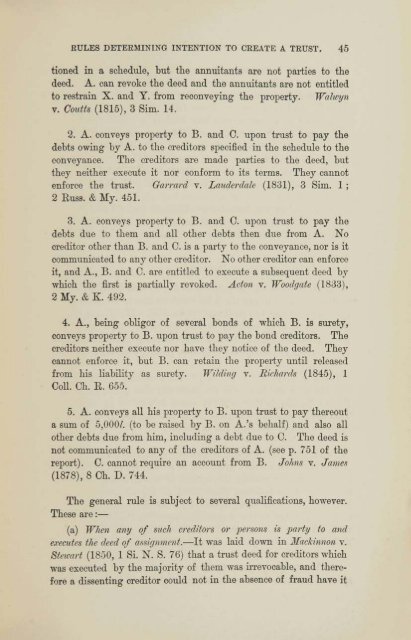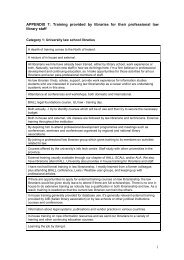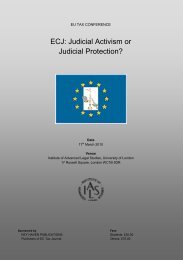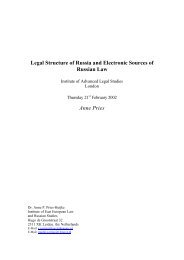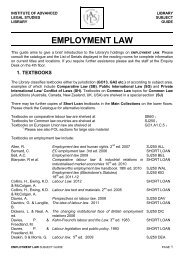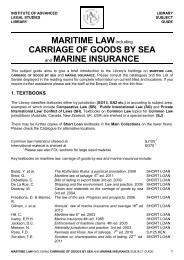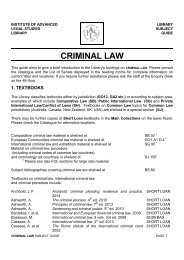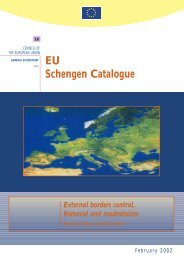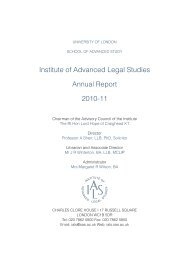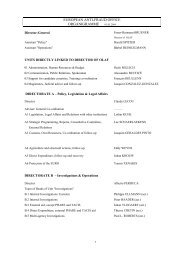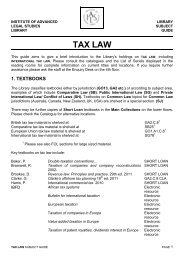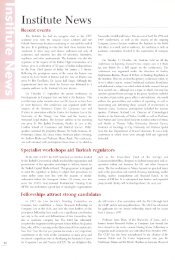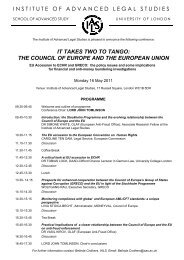a thesis - Institute of Advanced Legal Studies
a thesis - Institute of Advanced Legal Studies
a thesis - Institute of Advanced Legal Studies
You also want an ePaper? Increase the reach of your titles
YUMPU automatically turns print PDFs into web optimized ePapers that Google loves.
RULES DETERMINING INTENTION TO CREATE A TRUST. 45<br />
tioned in a schedule, but the annuitants are not parties to the<br />
deed. A. can revoke the deed and the annuitants are not entitled<br />
to restrain X. and Y. from reconveying the property. Walwyn<br />
v. Courts (1815), 3 Sim. 14.<br />
2. A. conveys property to B. and 0. upon trust to pay the<br />
debts owing by A. to the creditors specified in the schedule to the<br />
conveyance. The creditors are made parties to the deed, but<br />
they neither execute it nor conform to its terms. They cannot<br />
enforce the trust. Garrard v. Lauderdale (1831), 3 Sim. 1 ;<br />
2 Euss. & My. 451.<br />
3. A. conveys property to B. and 0. upon trust to pay the<br />
debts due to them and all other debts then due from A. No<br />
creditor other than B. and C. is a party to the conveyance, nor is it<br />
communicated to any other creditor. No other creditor can enforce<br />
it, and A., B. and 0. are entitled to execute a subsequent deed by<br />
which the first is partially revoked. Acton v. Woodgate (1833),<br />
2 My. & K 492.<br />
4. A., being obligor <strong>of</strong> several bonds <strong>of</strong> which B. is surety,<br />
conveys property to B. upon trust to pay the bond creditors. The<br />
creditors neither execute nor have they notice <strong>of</strong> the deed. They<br />
cannot enforce it, but B. can retain the property until released<br />
from his liability as surety. Wilding v. Richards (1845), 1<br />
Coll. Ch. E. 655.<br />
5. A. conveys all his property to B. upon trust to pay thereout<br />
a sum <strong>of</strong> 5,000/. (to be raised by B. on A.'s behalf) and also all<br />
other debts due from him, including a debt due to C. The deed is<br />
not communicated to any <strong>of</strong> the creditors <strong>of</strong> A. (see p. 751 <strong>of</strong> the<br />
report). C. cannot require an account from B. Johns v. James<br />
(1878), 8 Ch. D. 744.<br />
The general rule is subject to several qualifications, however.<br />
These are:—<br />
(a) When any <strong>of</strong> such creditors or persons is party to and<br />
executes the deed <strong>of</strong> assignment.—It was laid down in Mackinnon v.<br />
Stewart (1850, 1 Si. N. S. 76) that a trust deed for creditors which<br />
was executed by the majority <strong>of</strong> them was irrevocable, and therefore<br />
a dissenting creditor could not in the absence <strong>of</strong> fraud have it


